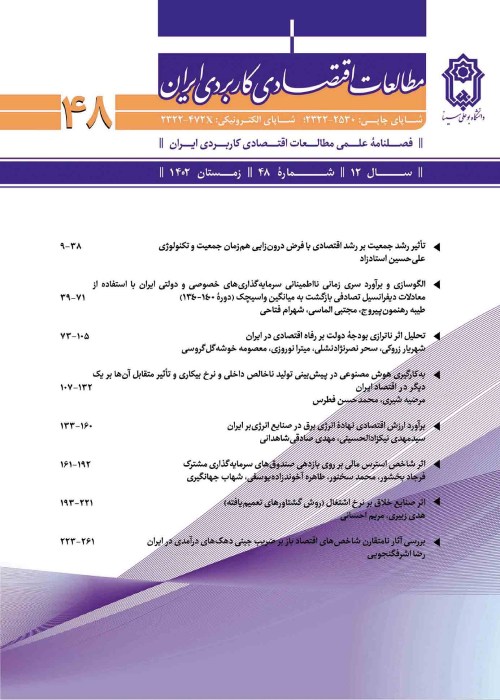The theory of Measuring Effects of Interest rate shock on the Macro factors in Iran: A Factor-Augmented Vector Autoregressive, Approach
Author(s):
Article Type:
Research/Original Article (دارای رتبه معتبر)
Abstract:
Goal: Imposing the discretionary interest rate renders the interest rate market susceptible to variety of shocks. Monetary officials should be well aware of the durability and temporal impacts of these shocks on the macroeconomic variables. Using 120 macroeconomic variables of Iran economy within the period of 1984-2013 , this study investigated whether there is a statistically significant relationship between the shadow reference interest rate (as a representative of the interest rate market) and prescribed interest rate? If so, what would be the consequence of the gap (difference) between these two rates in terms of the response of macroeconomic outlets?
Methodology
This paper estimates the "economy-wide" response to shocks to the interest rate using an iterative maximum likelihood estimation method.Applying Factor-Augmented Vector Autoregressive (FAVAR) method, it was investigated how macroeconomic variables respond to interest rate oscillations (shocks). To do so, first, key macroeconomic variables for Iran economy are identified (i.e., the variables that robustly represent Irans macroeconomic variables). As for the modeling, measurement and transfer equations have been assessed.Technically, the 120 time series constitute the measured part in a state space system. The state transition part of this system contains the dynamics of the driving forces and is represented as a vector autoregression of the shadow reference interest rate augmented by a few dynamic factors extracted from the large cross-section of time series. This state space system is denoted a factor-augmented VAR (FAVAR) by Bernanke et al. (2005). I estimate the FAVAR by the fully parametric one-step EM algorithm as an alternative to the two-step principal component method and the one-step Bayesian method in Bernanke et al. (2005). The EM algorithm which is an iterative maximum likelihood method estimates all the parameters and the dynamic factors simultaneously and allows for classical inference. I demonstrate empirically that the same impulse responses but better fit emerge robustly from a low order FAVAR with nine correlated factors compared to a high order FAVAR with fewer correlated factors, for instance six factors. This empirical result accords with one of the theoretical results from Bai & Ng (2007) in which it is shown that the information in complicated factor dynamics may be substituted by panel information.Results
According to Bai and Ng criteria, Expectation maximization, and the model, it is argued that GDP, monetary base, oil revenues, inflation, interest rate, and exchange rate are the key macroeconomic variables. Regarding the first question, it was shown that as the difference between the shadow reference interest rate and interest rate approaches zero, economic growth increases. This result has important policy implications: Policy makers are advised to set the prescribed interest rate close to the shadow reference interest rate. As for the second question, it was examined how the four main Iran economy outlets respond to the shocks in terms of durability and the temporal impact. The results indicate that as far as the temporal impact is concerned, capital market and exchange range exhibited the minimum (0.1 percent deviation from the mean) and maximum values (0.4 percent deviation from the mean), respectively. As for the durability, housing and banking outlets show approximately similar responses. It is worth noting that the standard deviations of shocks in interest rates caused delayed responses in GDP, unemployment, consumption, and bank deposits (one year delay). This demonstrated the rigidity of these variables. Inflation and capital market variables, however, do not show any rigidity. The same result has been reported as slow and fast moving variables in Bovin and Eliasz, (2005).Conclusion
The Central Bank should adopt necessary measures in response to the oscillations pertinent to the prescribed interest rate. Moreover, monetary officials should be well aware of the durability and temporal impacts of such oscillations on macroeconomic variables. Based on their thorough understanding of the impacts, the officials can introduce effective measures. In this study shadow reference interest rate significantly explains the macroeconomic variables. Policymakers are advised to set the prescribed interest rate close to shadow reference rate. Keywords:
Language:
Persian
Published:
Quarterly Journal of Applied Economics Studiesin Iran, Volume:7 Issue: 25, 2018
Pages:
29 to 54
magiran.com/p1819975
دانلود و مطالعه متن این مقاله با یکی از روشهای زیر امکان پذیر است:
اشتراک شخصی
با عضویت و پرداخت آنلاین حق اشتراک یکساله به مبلغ 1,390,000ريال میتوانید 70 عنوان مطلب دانلود کنید!
اشتراک سازمانی
به کتابخانه دانشگاه یا محل کار خود پیشنهاد کنید تا اشتراک سازمانی این پایگاه را برای دسترسی نامحدود همه کاربران به متن مطالب تهیه نمایند!
توجه!
- حق عضویت دریافتی صرف حمایت از نشریات عضو و نگهداری، تکمیل و توسعه مگیران میشود.
- پرداخت حق اشتراک و دانلود مقالات اجازه بازنشر آن در سایر رسانههای چاپی و دیجیتال را به کاربر نمیدهد.
In order to view content subscription is required
Personal subscription
Subscribe magiran.com for 70 € euros via PayPal and download 70 articles during a year.
Organization subscription
Please contact us to subscribe your university or library for unlimited access!


